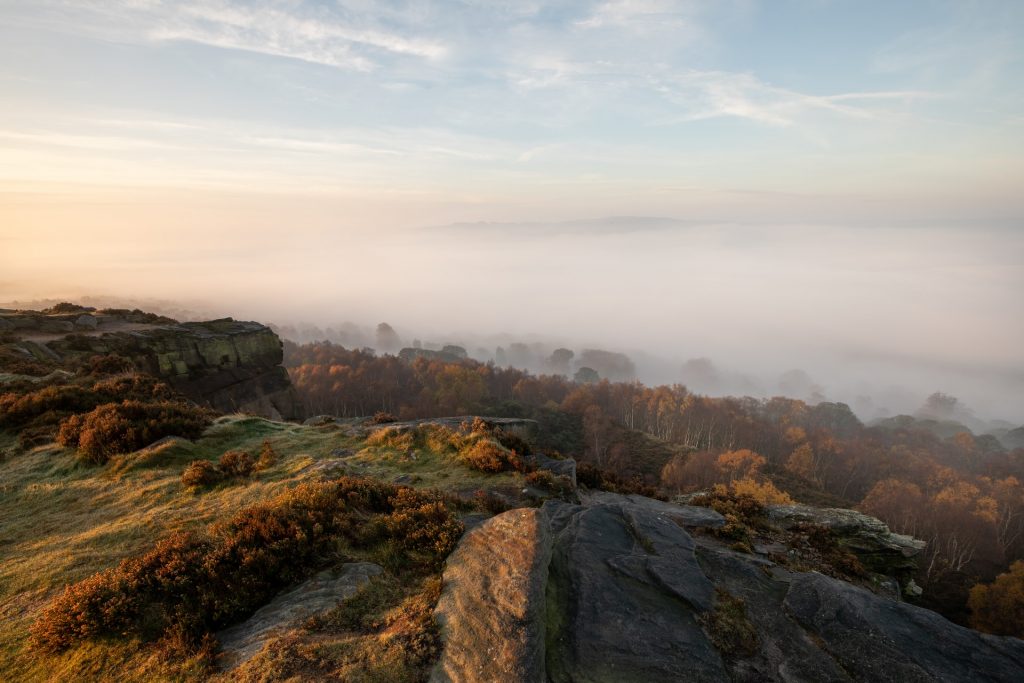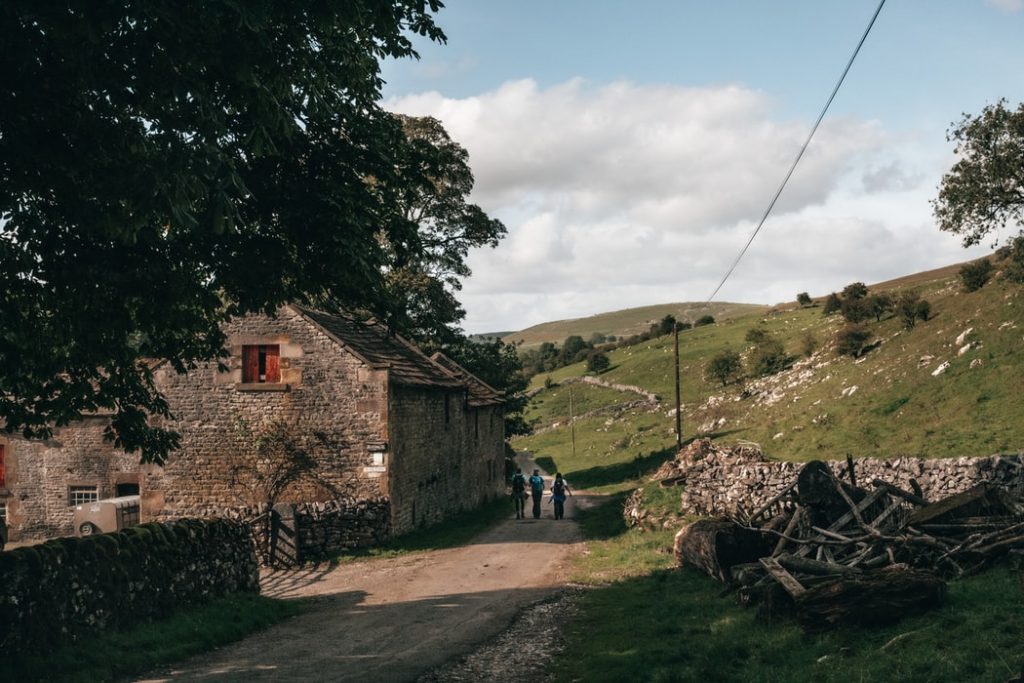The Peak District is a national park in central England that encompasses approximately 550 square miles of expansive landscapes and breathtaking scenery. Here, visitors can find a combination of rugged moorland, gently rolling meadows, and verdant dales and hills – the ‘peaks’ – the highest of which is Kinder Scout.
The Peak District is, in short (actually, it’s very tall), a wonderful place to explore.
Before we do explore, a couple of caveats; people already in the UK are currently allowed to visit the Peak District, though restrictions on the number of people staying in rented accommodation and attending indoor areas such as visitor centres do still apply. Right now, in England, hotels, hostels, and Airbnb rentals are all open, though there is a six person (or two households) maximum. The same limit on numbers applies to those staying in private homes, incidentally. Check out the government’s latest guidelines here, as they are likely to change in the coming days.
If you’re visiting from outside the UK, then the rules vary concerning the length of quarantine required and the number of negative COVID tests you have to provide, depending on whether the country of origin is on the green, amber or red list. Again, check the government’s latest rules regarding this here.
With those disclaimers dispensed with, let’s explore this iconic British destination more deeply. If you’re planning to visit the Peak District this summer, here’s how to prepare.
WHAT IS THE PEAK DISTRICT?
For the benefit of the uninitiated, the Peak District is a national park in England, made up of the limestone moorland of Derbyshire and the Torrs and gritstone moorlands of Cheshire. It is famous for its upland scenery, especially its limestone crags and rock formations, which are also found in the French Alps, the Southern Fells of the Lake District, and the Scottish Highlands.
WALKS
The Peak District is something of a national treasure, as it is home to some of the most beautiful landscapes and walks in Britain. There is so much to do here that you will need to plan out an itinerary before you arrive. With more than 200 miles of walking and many hills, the Peak District is a walker’s dream.
Perhaps the most famous and well trodden is the Pennine Way, which runs over 650 miles from Scotland to the Midlands.
The Pennine Way is renowned for its scenic beauty and cultural heritage and is the second most popular long-distance walk in the UK, with around 110,000 people taking part every year. Many people use the quaint village of Edale as a starting off point to walk the Pennine way (a 268-mile trek that takes most hikers up to 19 days) but if you’re looking for a more relaxed walk, you could try the Edale Low Level Circular Walk, which will take you on a picturesque, steady route.
Alternatively, the walk from Edale to Hollins Cross takes you off in a different direction to the Edale walks, and here’s some good news after all that hard work; this is an easy walk along a public footpath, suitable for seasoned hikers and newbies alike. The path takes you up to the Hollins Cross memorial, from which you get a fantastic view of the surrounding landscape.
Another popular walking route is the Dales Way, which takes you through the beautiful valleys of north Derbyshire. Bakewell in the south leads to Castleton in the Peak District in the north along the Peak District Trail. It then cuts northeast through the picturesque valley of the River Wye, crosses the stunning summit of Kinder Scout, and finishes at the Peak District National Park Centre at Ashford-in-the-Water.

SOME OTHER PLACES OF INTEREST IN THE PEAK DISTRICT
The Peak District is home to plenty of places of interest, some rural and natural, and some manmade. Here’s a selection of our favourites…
- Chatsworth House: If you are interested in stately homes, this should definitely be on your list. Completed in 1708, it is a masterpiece of English opulence, and is open to the public during the summer months. Right now, COVID-19 restrictions do apply here.
- Mam Tor: There are well over 100 Northumberland hills called Mam Tor, but only one is an actual peak. Mam Tor, known as the ‘mother hill’, is an isolated hill with a pyramid-shaped summit rising to a rocky prominence of over 1,000 feet. The whole of the summit is covered in heather moorland, or common heather, and the summit cairn is an interesting and distinctive landmark.
- Kinder Scout: A stunningly desolate moorland plateau. The name is said to be pre-English in origin, and this gorgeous location feels as ancient as its namesake.
- Heights of Abraham: Named after a supposed resemblance to a similarly named location in Canada where the British officer, General Wolfe, died in battle.
THINK ABOUT ACCOMMODATION
Accommodation options in the Peak District are, generally, traditional and fairly rural in terms of their location and amenities. You won’t find many 5 star, all inclusive affairs here, but rather, quaint cottages, B&Bs and guesthouses giving a gentle glimpse into a slower pace of British life.
Alternatively, and with so many hotels booked up well in advance due to increased demand for staycations, you could take advantage of the numerous campsites and camping spots found in the Peaks and set up a tent or park up a caravan, instead.
One option could be to get car tent, set it up on your vehicle and camp out where you park. This isn’t as impromptu as it sounds, however, and you will need to either book in with the camping site or caravan park in advance, or gain permission from the landowner.
The Peak District’s official tourism page has an extensive list of campervan and caravan parks – do check it out.
This is a fabulous way to get immersed in the natural beauty of the place, of which there is an abundance. However, you must make sure that you dispose of all waste properly and disturb the local wildlife. While it may not seem as wild as some other locations due to its proximity to local villages and towns, it does have its own unique nature and sensitive ecosystems.

HOW TO GET THERE
For international visitors, you’ll likely arrive at Manchester airport. From here, there are extensive rail networks from Manchester Piccadilly that link up with Edale in Derbyshire or Sheffield. After the latter, you can head to Hope train station for access to the Peaks. Both are excellent starting points for your trip. If you’re coming from London via train, then Euston to Manchester Piccadilly takes just two hours.
WHAT TO BRING
If you’re planning on spending your time walking the Peak District’s many trails, then you will need to think about packing the right items. At a minimum, it’s recommended that you bring:
- Rucksack: An item that’s always useful when hiking since it can hold all the your necessities.
- Walking sticks: These are lightweight, telescopic poles that help you to climb the steeper hills.
- Water: Always bring plenty of water; dehydration can occur even on the most unsuspecting of days.
- Powerpack: While you might get a signal everywhere you go, you will still need your phone juiced up and ready for photo duty.
- Raincoat: UK weather is notoriously changeable, and even if you begin your trek in glorious sunshine, it might end in torrential rainfall.
- First Aid Kit: A simple kit will suffice. Band-aids and bandages should get you through any non-emergency medical issue until you get back to your accommodation.
- Penknife: It’s always handy to have a multi-tool penknife with you, especially one with a corkscrew and bottle opener.
Read: 5 IDEAL tips for a walking holiday in the UK

NEVER UNDERESTIMATE YOUR SURROUNDINGS
The UK’s scenery can shift from urban to rural in the blink of an eye, and this can sometimes lead to complacency when setting off on an outward bound adventure. On the peaks and in the moorlands, there’s always a risk of getting lost, stranded or even injured, particularly if the weather takes an all-too-predictable turn.
Ensure others know where you are and always be aware of your surroundings. This could be by informing the staff at your hotel or family members of your plans for the day. Understand that the weather can change instantly, and if you are caught out with the wrong gear, you could end up in a tight spot.
The Peak District is a beautiful place to visit all year round, especially during the summer. By ensuring that you create an itinerary and know the places to visit, you will have a fantastic time.





